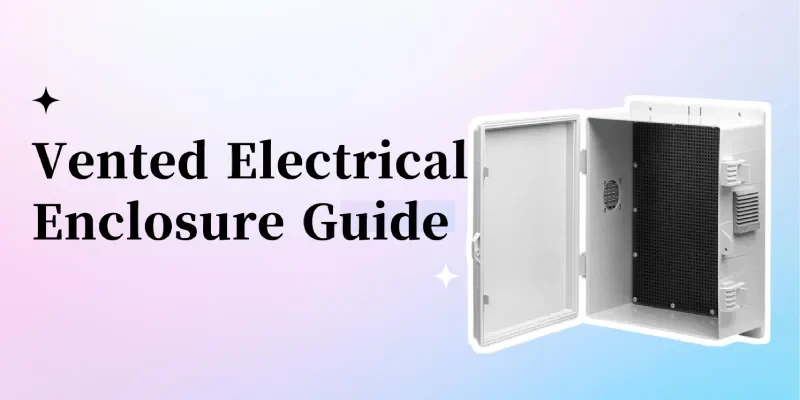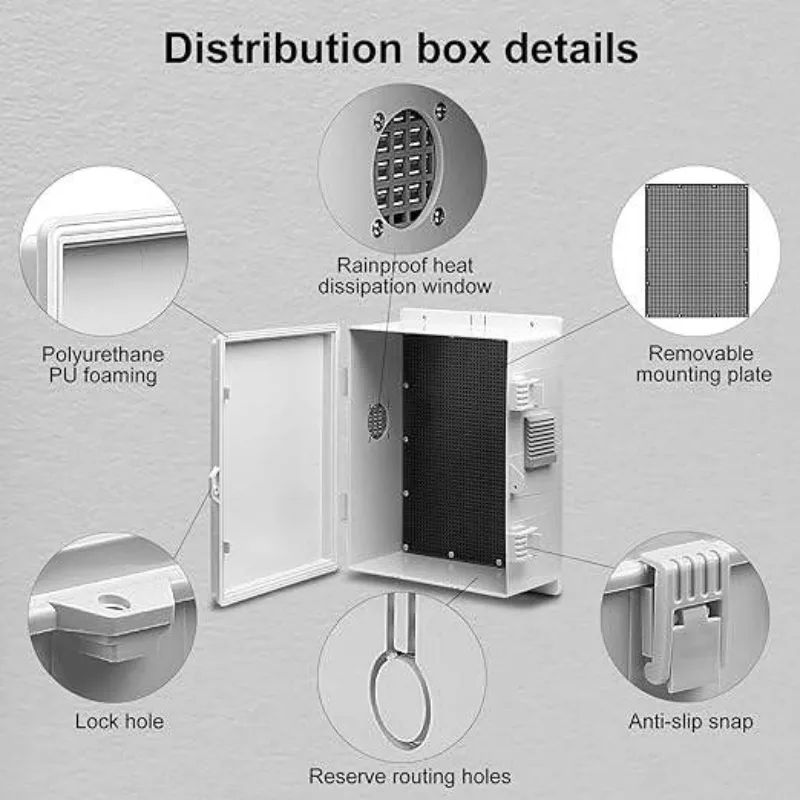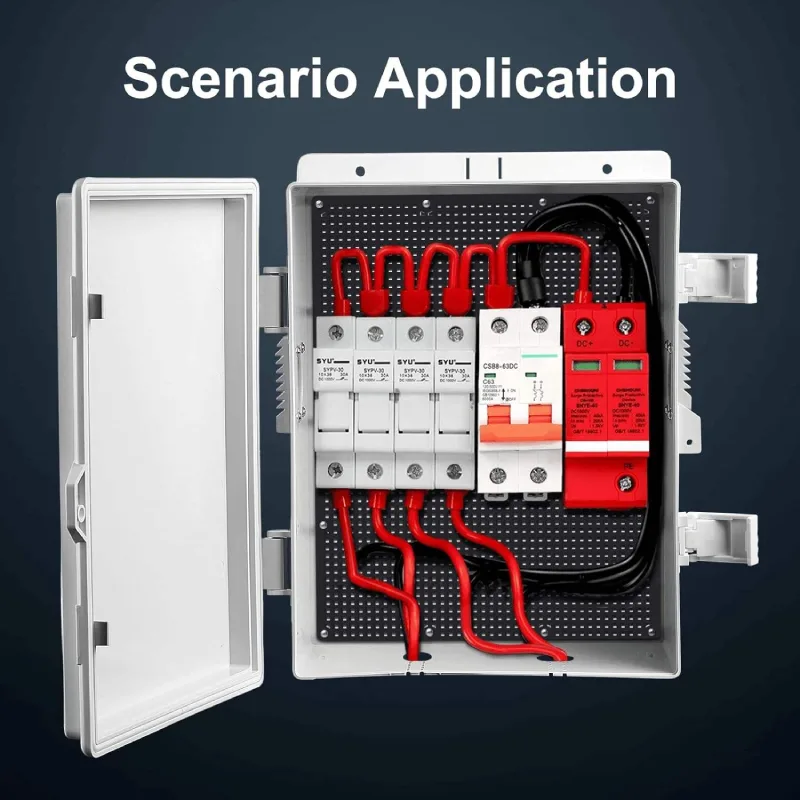Vỏ tủ điện thông gió là loại vỏ chuyên dụng được thiết kế để bảo vệ các thành phần điện đồng thời cho phép luồng không khí lưu thông đầy đủ, rất quan trọng để quản lý nhiệt và độ ẩm trong các ứng dụng công nghiệp và thương mại khác nhau. Các vỏ tủ này có các cơ chế thông gió như lỗ thông hơi thụ động, cửa chớp hoặc hệ thống khí cưỡng bức để duy trì nhiệt độ hoạt động tối ưu và ngăn ngừa sự ngưng tụ, đảm bảo tuổi thọ và độ tin cậy của thiết bị điện được chứa bên trong.
Cơ chế thông gió
Vỏ tủ điện thông gió sử dụng các cơ chế thông gió khác nhau để duy trì các điều kiện bên trong tối ưu. Các cơ chế này bao gồm từ các hệ thống thụ động đến các giải pháp chủ động phức tạp hơn, mỗi cơ chế được thiết kế để giải quyết các nhu cầu cụ thể về làm mát và kiểm soát độ ẩm. Dưới đây là các cơ chế thông gió chính được sử dụng trong vỏ tủ điện:
- Lỗ thông hơi thụ động: Các lỗ hoặc tấm có rãnh đơn giản cho phép lưu thông không khí tự nhiên thông qua đối lưu. Thường được đặt ở phía dưới và phía trên của vỏ tủ để tạo hiệu ứng ống khói.
- Lỗ thông hơi có bộ lọc: Tích hợp bộ lọc không khí để ngăn bụi và mảnh vụn xâm nhập vào vỏ tủ đồng thời cho phép luồng không khí. Chúng rất quan trọng để duy trì môi trường bên trong sạch sẽ.
- Lỗ thông hơi cân bằng áp suất: Các lỗ thông hơi chuyên dụng cho phép cân bằng áp suất giữa bên trong và bên ngoài vỏ tủ, bảo vệ chống lại sự xâm nhập của hơi ẩm và duy trì tính toàn vẹn của lớp đệm.
- Hệ thống khí cưỡng bức: Các giải pháp làm mát chủ động sử dụng quạt hoặc máy thổi để lưu thông không khí qua vỏ tủ, cung cấp khả năng tản nhiệt hiệu quả hơn cho các ứng dụng tỏa nhiệt cao.
- Cửa có rãnh: Cửa có khe thông gió tích hợp hoặc lỗ thông hơi dập, thường được đặt một cách chiến lược để tối ưu hóa sự lưu thông không khí.
- Lỗ thông hơi chống chịu thời tiết: Được thiết kế cho các ứng dụng ngoài trời, các lỗ thông hơi này cho phép luồng không khí đồng thời bảo vệ chống lại sự xâm nhập của nước, phù hợp với vỏ tủ được xếp hạng NEMA.
Mỗi cơ chế này có thể được điều chỉnh cho phù hợp với các điều kiện môi trường và yêu cầu thiết bị cụ thể, đảm bảo hiệu suất và tuổi thọ tối ưu của các thành phần điện được chứa bên trong.
Lợi ích của vỏ tủ thông gió
Vỏ tủ thông gió mang lại một số lợi thế chính cho hệ thống điện. Chúng kiểm soát nhiệt độ hiệu quả bằng cách tạo điều kiện cho luồng không khí, giúp duy trì các điều kiện hoạt động tối ưu cho các thành phần điện tử, do đó kéo dài tuổi thọ và độ tin cậy của chúng. Các vỏ tủ này cũng đóng một vai trò quan trọng trong việc ngăn ngừa sự ngưng tụ bằng cách giảm mức độ ẩm bên trong, giúp bảo vệ chống lại sự ăn mòn và đoản mạch. Ngoài ra, các lỗ thông hơi cho phép cân bằng áp suất, điều chỉnh các thay đổi do biến động nhiệt độ hoặc thay đổi độ cao, điều này rất cần thiết để duy trì tính toàn vẹn của các miếng đệm và gioăng được sử dụng trong vỏ tủ. Tính năng cân bằng áp suất này đặc biệt quan trọng trong việc bảo vệ chống lại bụi, nước, dầu và dung môi trong các ngành công nghiệp khác nhau.
Ứng dụng công nghiệp
Vỏ tủ điện thông gió được sử dụng rộng rãi trong các ngành công nghiệp khác nhau do khả năng bảo vệ các thành phần điện đồng thời quản lý nhiệt và độ ẩm. Dưới đây là tổng quan về các ứng dụng công nghiệp chính:
- Chế tạo: Được sử dụng để chứa các hệ thống điều khiển, thiết bị đóng cắt và máy biến áp, cung cấp thông gió cho thiết bị phát nhiệt trong môi trường nhà máy.
- Viễn thông: Lý tưởng cho việc lắp đặt thiết bị mạng ngoài trời, với vỏ tủ thông gió chống chịu thời tiết giúp loại bỏ nhiệt trong môi trường nhiệt độ cao.
- Năng lượng: Được sử dụng trong các hệ thống phân phối điện, bảo vệ các thành phần điện đồng thời cho phép cân bằng áp suất và tản nhiệt.
- Tự động hóa công nghiệp: Chứa thiết bị điều khiển nhạy cảm, duy trì nhiệt độ hoạt động tối ưu cho PLC, ổ đĩa và các thành phần tự động hóa khác.
- Tiện ích ngoài trời: Vỏ tủ thông gió chống chịu thời tiết bảo vệ thiết bị khỏi các yếu tố môi trường đồng thời cho phép luồng không khí cần thiết để làm mát.
- Trung tâm dữ liệu: Được sử dụng để chứa máy chủ và thiết bị mạng, với các hệ thống thông gió rất quan trọng để duy trì nhiệt độ thành phần trong giới hạn thiết kế.
- Ứng dụng hàng hải: Vỏ tủ thông gió chuyên dụng bảo vệ chống ăn mòn do nước muối đồng thời cho phép cân bằng áp suất trong môi trường thay đổi.
Các ứng dụng này chứng minh tính linh hoạt của vỏ tủ điện thông gió trong việc giải quyết các nhu cầu đa dạng của ngành về bảo vệ thiết bị và quản lý nhiệt.
Những cân nhắc về thiết kế
Khi lựa chọn hoặc thiết kế vỏ tủ điện thông gió, cần xem xét một số yếu tố chính để đảm bảo hiệu suất và khả năng bảo vệ tối ưu. Lượng nhiệt do các thành phần được chứa bên trong tạo ra là rất quan trọng, vì các thiết bị lớn hơn hoặc hiệu suất cao có thể yêu cầu các giải pháp thông gió mạnh mẽ hơn. Các điều kiện môi trường, bao gồm nhiệt độ, độ ẩm và mức độ bụi, cần được đánh giá cẩn thận để xác định mức độ bảo vệ cần thiết và loại thông gió cần thiết. Điều quan trọng nữa là phải đảm bảo tuân thủ các tiêu chuẩn an toàn có liên quan như NEMA hoặc IEC, tùy thuộc vào ứng dụng cụ thể. Ngoài ra, việc lựa chọn vật liệu, chẳng hạn như thép không gỉ, thép mạ kẽm hoặc nhôm, phải dựa trên các yêu cầu về độ bền và khả năng chống lại các yếu tố môi trường.




